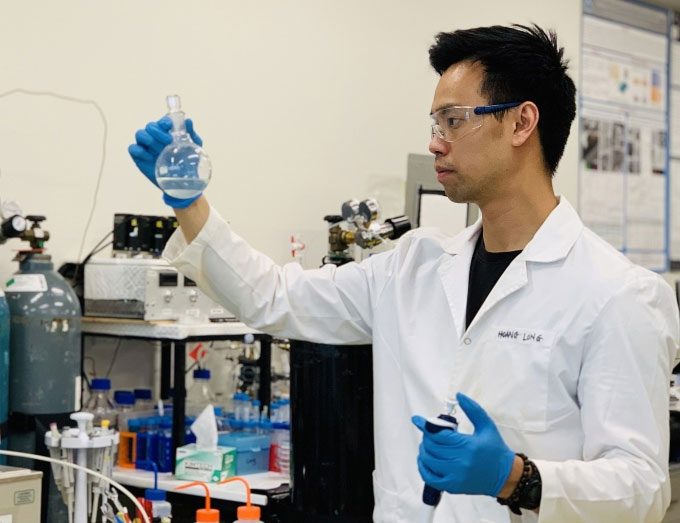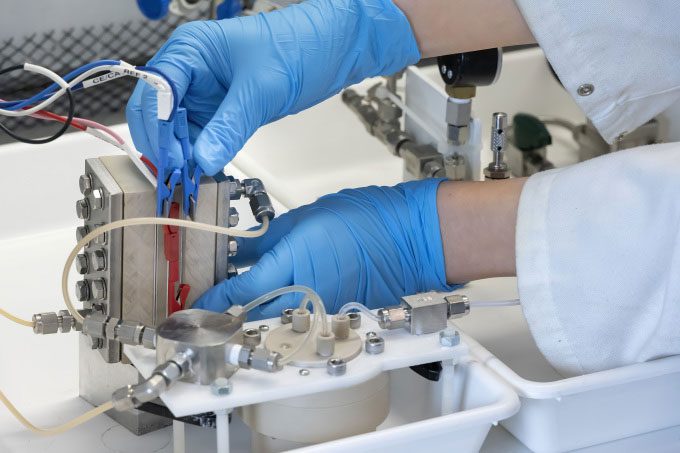Using an electrochemical device, Dr. Dư Hoàng Long and his colleagues are researching the conversion of nitrogen gas into ammonia for use in agriculture and the chemical industry.
As the lead researcher, Dr. Dư Hoàng Long (34 years old) and scientists at Monash University, Australia, have recently made a breakthrough in the development of the ammonia production process, a crucial component in fertilizers for global food production.
Currently, most ammonia in the industry is synthesized using the Haber–Bosch method (a reaction combining hydrogen from fossil fuels and nitrogen gas). However, according to the Industrial Productivity Institute, statistics from 2010 indicate that this process emits approximately 451 million tons of carbon. Therefore, the research results are seen as a solution to the problem of clean ammonia sourcing.
“If successful, renewable energy will be stored in the form of ammonia and exported,” Dr. Dư Hoàng Long shared with a reporter. The group’s project was conducted over two years.

Dr. Dư Hoàng Long in the research lab at Monash University, Australia. (Photo: NVCC)
Using the electrochemical reduction of nitrogen gas (N2) with the assistance of lithium (Li), the team developed a unique electrolyte that produces a highly active electron layer on the electrode surface, enabling the most efficient conversion of nitrogen gas into ammonia to date. The new process achieves nearly absolute efficiency and is more flexible in scale compared to conventional methods. The research results were recently published in Nature, which has an impact factor of 69.5.
Dr. Long noted that a key highlight of the research is that the team developed an electrolyte capable of maintaining the stability of the electrode surface throughout the operation, allowing for high productivity and nearly 100% efficiency, a feat that has not been achieved in previous research.
Professor Douglas MacFarlane, a member of the team, further explained that by switching to bis(trifluoromethylsulfonyl) imide electrolyte, the research team created a system that can suppress unwanted side reactions with a suitable ion coating, thereby stabilizing the formation of lithium metal and primarily producing ammonia. “This addresses the problem from two aspects: it not only enhances the efficiency and effectiveness of the process but also makes it more stable as it is not affected by side reactions,” he said.
Professor MacFarlane remarked that achieving nearly 100% efficiency is a significant breakthrough that could establish a stable process for sustainable ammonia production. The research findings indicate that the electrochemical ammonia synthesis system in the laboratory can achieve 0.8g of ammonia per day per 1cm2 of electrode. Thus, scaling up the process to match current industrial productivity looks promising.

Electrochemical device developed by Monash University scientists. (Photo: Steve Morton).
“This research is a breakthrough that opens the path to producing ammonia solely from electrical energy,” Dr. Charlie Day, CEO of Jupiter Ionics, shared with a reporter via email. He noted that eliminating emissions from ammonia production is one of humanity’s significant challenges if we want to achieve the goals of the Paris Agreement on reducing greenhouse gas emissions. With renewable energy sources like solar and wind becoming cheaper and more widespread, this process could help accelerate the transition to a world with zero CO2 emissions while maintaining global food system productivity.
Dr. Charlie Day’s company focuses on industrializing the clean ammonia production process through electrochemical methods. They expect to complete the first prototype for trials in the Victoria region next year. “The important thing is that the new process allows for flexibility in various sizes and scales while still utilizing abundant and inexpensive renewable energy,” Dr. Day stated. He believes that not only will this significantly reduce emissions, but the system will also address the instability of fertilizer prices, paving the way for a better future for global food production.
| Dr. Dư Hoàng Long was born in Ho Chi Minh City. He graduated with a degree in mechanical engineering from Petronas Technical University, Malaysia; subsequently, he earned a master’s degree in Energy and Environment from the Korea Institute of Science and Technology. Dr. Long received his PhD in Chemistry from Monash University and currently serves as a research fellow at the Department of Chemistry at the same institution. His primary research focus is on electrochemistry, renewable energy, and energy conversion. He has over 20 published works in prestigious scientific journals such as Nature, Science, Nature Catalysis, and various journals within the American Chemical Society’s publishing system. Dr. Long expressed his readiness to collaborate with domestic research groups interested in this field. |



















































